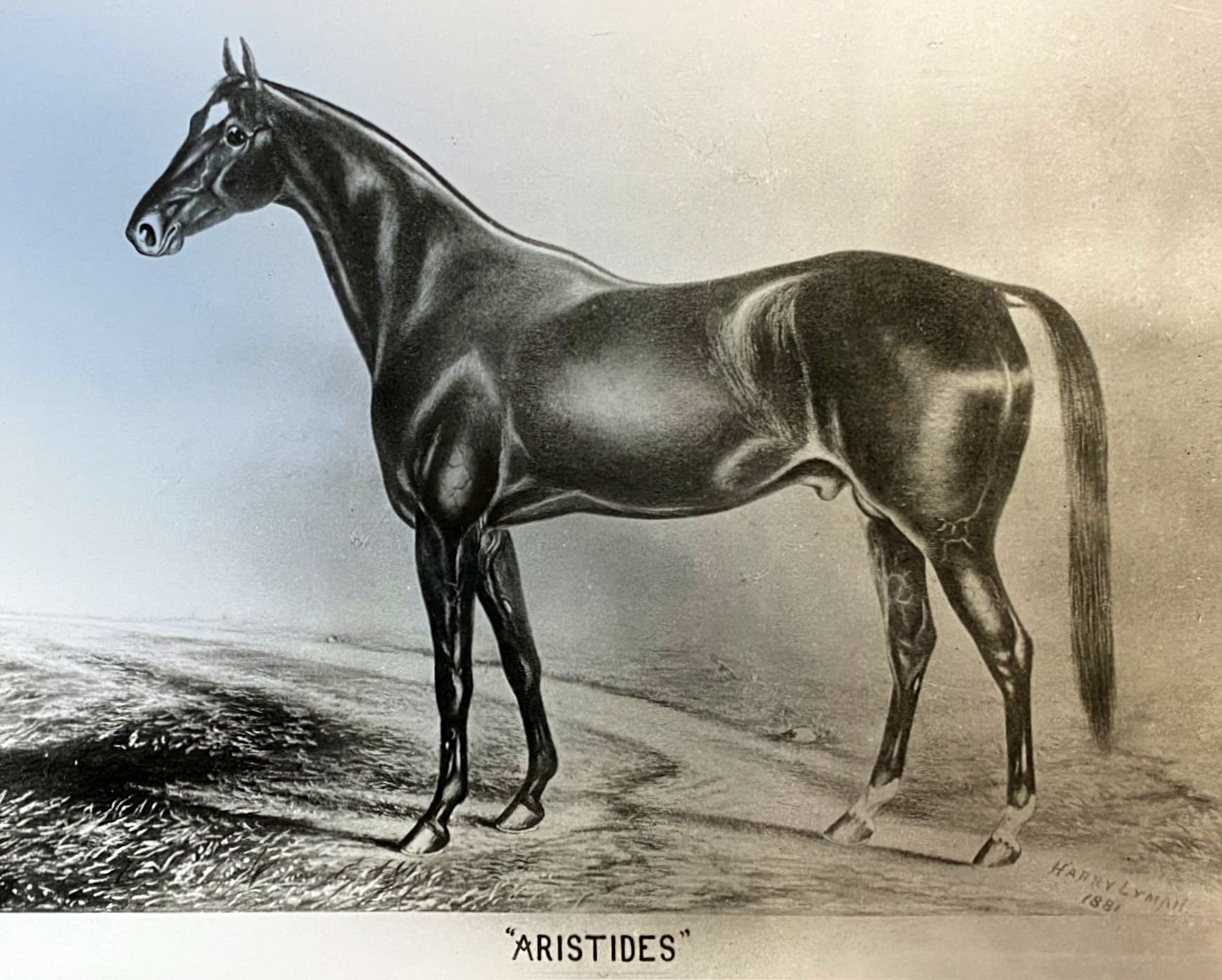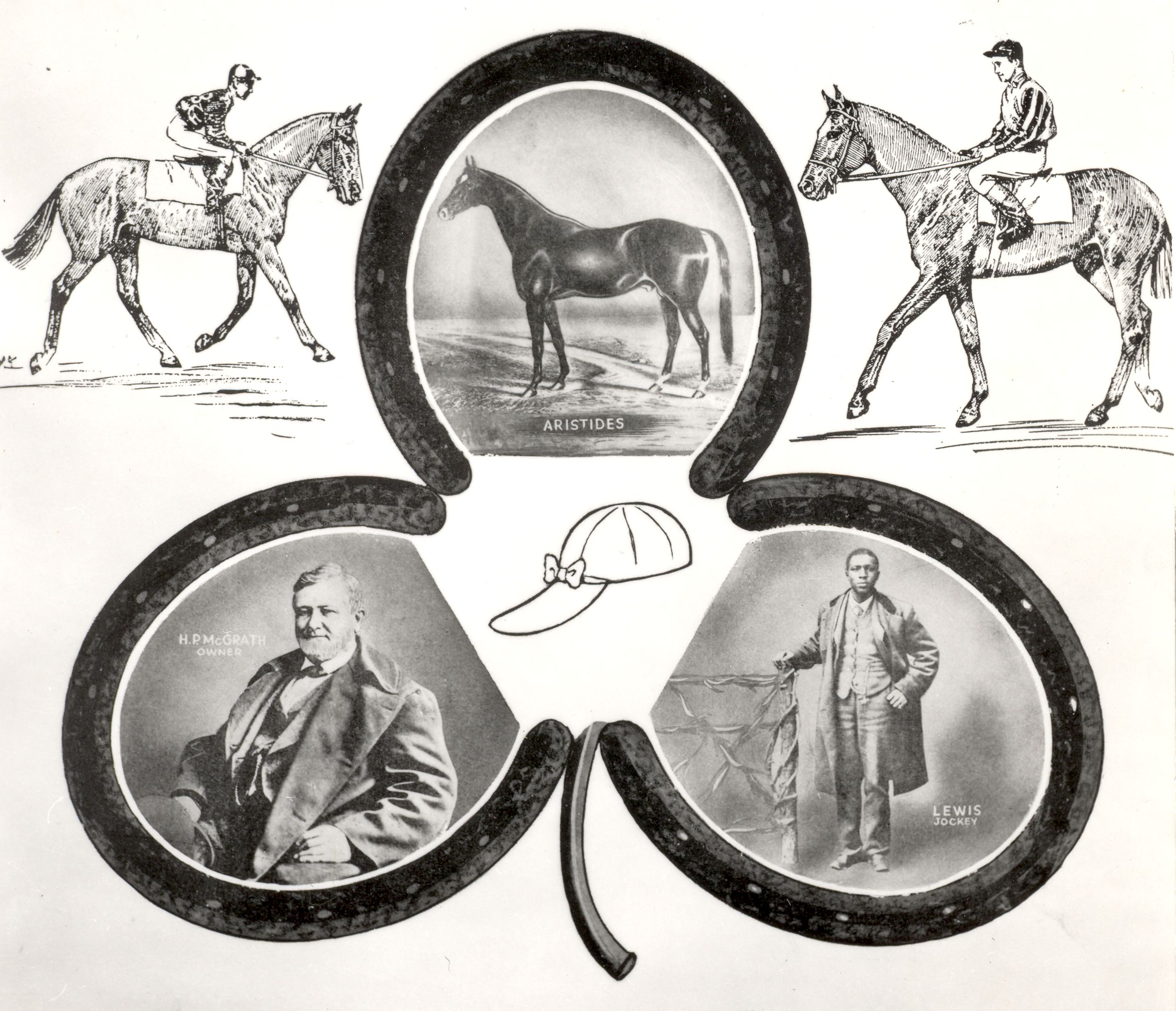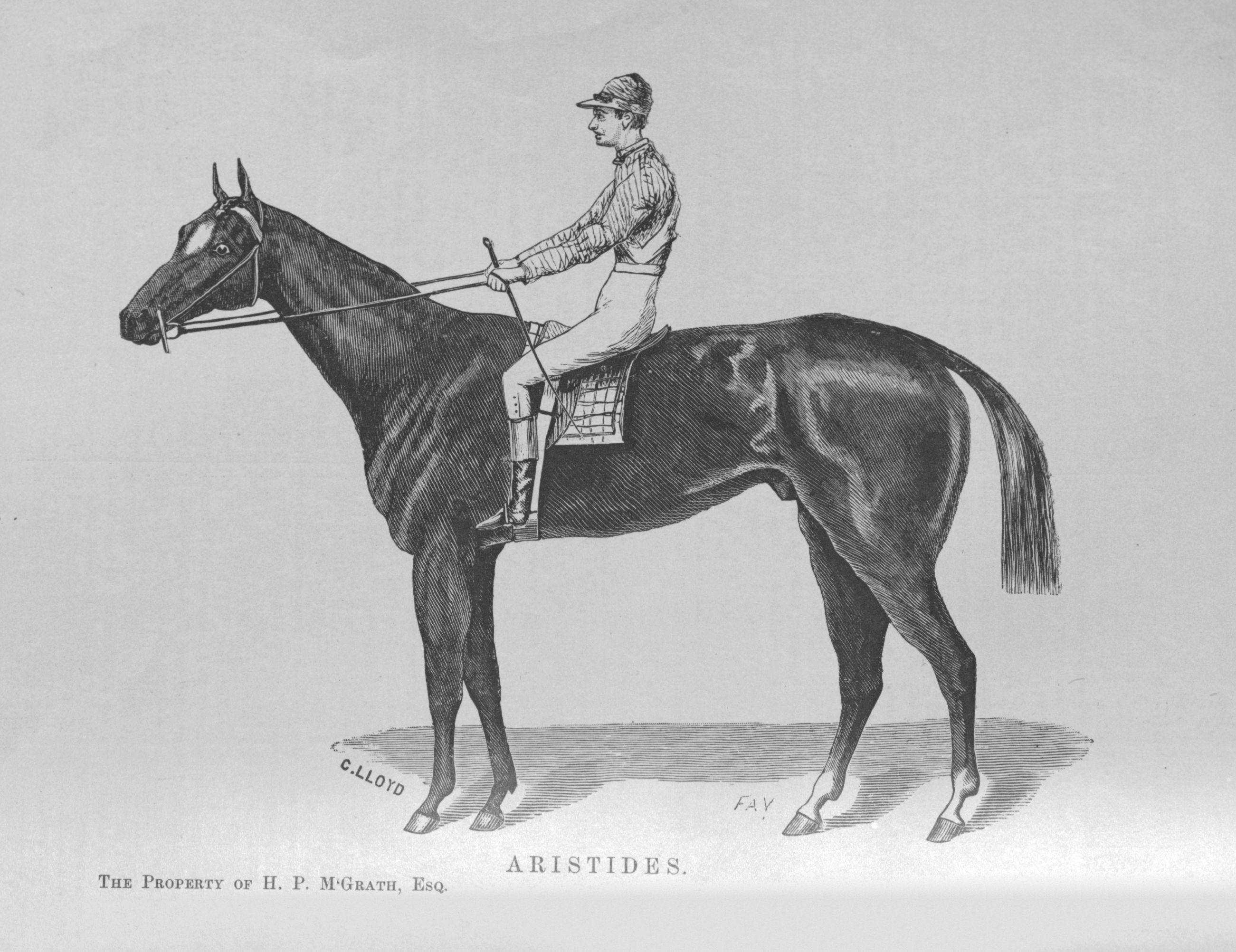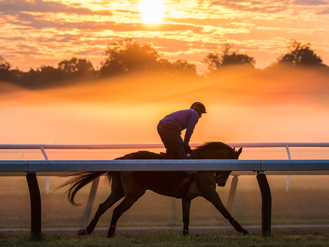Aristides (KY)
The name Aristides was derived from the ancient Greek words “aristos,” which means “best,” and “eidos,” defined as “type” or “species.” The name was carried by an obscure second-century saint and later more famously by a fifth-century Athenian statesman, “Aristides the Just,” who was lauded for his integrity. On May 17, 1875, a small chestnut racehorse bearing the historic name Aristides proved to be the “best of his type” in a new sporting spectacle that generated tremendous anticipation prior to its debut — the inaugural Kentucky Derby.
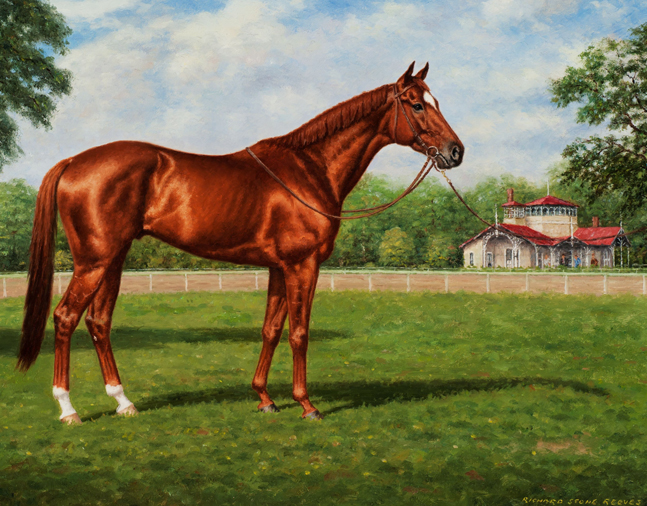
2024
1872
Leamington (GB)
Sarong
Lexington
H. P. McGrath
H. P. McGrath
Ansel Williamson
1874-1878
$18,325
Racing Record
21
Starts
| 1874 | 9 | 3 | 3 | 0 | $1525 $1,525 |
| 1875 | 9 | 4 | 2 | 1 | $15700 $15,700 |
| 1876 | 4 | 2 | 2 | 0 | $1100 $1,100 |
| 1877 | 0 | 0 | 0 | 0 | $0 $0 |
| 1878 | 1 | 0 | 0 | 0 | $0 $0 |
Biography
The name Aristides was derived from the ancient Greek words “aristos,” which means “best,” and “eidos,” defined as “type” or “species.” The name was carried by an obscure second-century saint and later more famously by a fifth-century Athenian statesman, “Aristides the Just,” who was lauded for his integrity. On May 17, 1875, a small chestnut racehorse bearing the historic name Aristides proved to be the “best of his type” in a new sporting spectacle that generated tremendous anticipation prior to its debut — the inaugural Kentucky Derby.
Facing 14 opponents at the new Louisville Jockey Club track — later to officially be named Churchill Downs — the overlooked Kentucky-bred son of imported British sire Leamington put on quite a show for the 10,000 in attendance. Winning by two lengths and setting a new American record of 2:37¾ for a 3-year-old at the 1½-mile distance, Aristides was the first name recorded into the Derby record book.
Aristides was officially a Kentucky-bred from Fayette County, but New York can also stake a claim to his fame. In the spring of 1872, Aristides was foaled at the McGrathiana Stud Farm of his Kentucky breeder and owner, Henry Price “H. P.” McGrath. The actual breeding of Aristides, however, took place far from the Bluegrass State. In 1871, McGrath sent his mare Sarong, a daughter of the mighty stallion Lexington, to New York to be covered by Leamington at a farm in Westchester County. Back in Kentucky the following spring, Sarong produced a blood-red chestnut colt with a pair of white socks and a star on his forehead. Following the mating with Sarong, Leamington was purchased by McGrath’s friend, Aristides Welch, and moved to his Erdenheim Farm in Pennsylvania. Hence, McGrath named Aristides in honor of Welch, not the Greek politician or the saint.
McGrath enjoyed significant success as both a breeder and owner of racehorses. In 1870, he bred the great Tom Bowling, who won 14 of 17 career races en route to the Hall of Fame. When it was time to send Aristides into training, McGrath turned to Ansel Williamson, who conditioned Tom Bowling and numerous other standouts in the pre- and post-Civil War years, including the undefeated 1861 foals Asteroid and Norfolk. Born into slavery in Virginia around 1806, Williamson became revered as one of America’s finest trainers — and eventually a Hall of Famer.
McGrath had a trio of promising 2-year-olds in the spring of 1874. Along with Aristides, the stable featured Calvin and Chesapeake, both of whom were half-brothers to previous McGrath runners. Calvin was a half to Tom Bowling out of McGrath’s mare Lucy Fowler, while Chesapeake was a half to Tipperary. Perhaps it was this history that initially led McGrath to favor those two more than Aristides.
Nevertheless, Aristides was regarded as a quality prospect when he arrived at the races for the first time on May 12, 1874, at the old Kentucky Association track in Lexington. He finished a respectable second in a half-mile sweepstakes before going unplaced in both the Juvenile Stakes at Jerome Park in New York and the Hopeful Stakes at Long Branch in New Jersey. Aristides was then second in the Thespian Stakes at Long Branch and off the board in a six-furlong event at Saratoga. He finally broke his maiden in his sixth attempt, winning a one-mile handicap at Saratoga on Aug. 18. In his three remaining starts that year, Aristides won twice with a second-place effort sandwiched between.
Although on the improve, Aristides remained overshadowed among the McGrath horses. Chesapeake was regarded as the leading juvenile of 1874 thanks to Saratoga victories in the August Stakes and Kentucky Stakes. Calvin, meanwhile, was also well thought of after winning the July Stakes at Long Branch. By the spring of 1875, Aristides was starting to be referred to as the “little red horse,” perhaps a slight when being mentioned alongside his more accomplished stablemates.
A reporter for the Kentucky Live Stock Record had a different take on Aristides when he visited McGrath’s farm that April to analyze the runners. The reporter described Aristides as a “lengthy, wiry, even-balanced horse, deep through the heart, and with long, muscular thighs. … Ansel has got him pretty near a racing form already.”
Aristides, however, struggled in the mud during his sophomore debut in the Phoenix Hotel Stakes at Lexington, a race easily won by the emerging sensation Ten Broeck. Chesapeake, meanwhile, won the first race of his 3-year-old season, defeating Ten Broeck and three others in the Citizens’ Stakes at Lexington.
Based on those efforts, Chesapeake was considered the horse to beat in the first Kentucky Derby, which was held on a Monday. The track and the race were both conceptualized and developed by Meriwether Lewis Clark, Jr., who envisioned following the style of the English classic races with a 1½-mile distance (which remained the Kentucky Derby distance until shortened to its present 1¼ miles in 1896).
The Louisville Courier-Journal foreshadowed what the Derby would become: “Today will be historic to Kentucky annals,” the paper commented, “as the first ‘Derby Day,’ of what promises to be a long series of annual turf festivities which we confidently expect our grandchildren 100 years hence, to celebrate in glorious continuous rejoicings, because the president (Clark) hopes to make this a duplicate for the great English turf event.”
With both Chesapeake and Aristides entered in the Derby, McGrath desired a fast early pace to set up the late-charging Chesapeake. Aristides was designated the “rabbit” for the task, but those plans never came to fruition. In the irons aboard Aristides for the Derby was 19-year-old Oliver Lewis, one of the 13 Black jockeys among the 15 riders in the field. Lewis understood the intentions of McGrath and rode as instructed.
Aristides pushed the issue early, battling for the lead with McCreery through a quarter in :25½ and a half of :50 flat, brisk fractions for the era. Lewis nudged Aristides into the lead on the backstretch and the contenders began to separate from the pretenders.
“The others seemed to be outpaced,” reported the Courier-Journal, “for Aristides was cutting out the running at an awful speed, getting back to the finish of the mile in the neighborhood of 1:43.”
Aristides was keeping up his end of the bargain, but where was Chesapeake? As Aristides entered the far turn, Lewis began to rein him in a bit, but Chesapeake was well out of contention. McGrath was standing at the top of the stretch and knew his hopes were alone with Aristides. With Chesapeake beaten, McGrath signaled Lewis to “go on with the good little red horse and win if he could all alone,” according to the memoirs of Matt Winn, the Churchill impresario who attended every Derby from 1875 through 1949.
Even though he was pushed through demanding early fractions, Aristides had plenty left in the tank in the homestretch.
“Right gallantly did the game and speedy son of Leamington and Sarong answer the call on his forces,” reported the Courier-Journal, “for he held his own all down the stretch, in spite of a most determined rush on the part of Volcano and Verdigris, and dashed under the wire the winner of one of the fastest and hardest races ever seen on a track. Aristides forced the pace all the way for his stable companion Chesapeake, and so had no respite at all, which makes his performance a very remarkable one.”
The Kentucky Live Stock Record added that once Aristides turned for home the race “was never in doubt, Aristides winning by two lengths with something in hand.”
Aristides earned a purse of $2,850 for the historic victory.
Following the Derby, Aristides won the Withers Stakes at Jerome Park, then finished third in the Belmont to Calvin. Unfortunately for the legacy of Aristides, McGrath again favored the stablemate. Earlier in the year, McGrath had staked a huge sum on Calvin winning the Belmont. As was the case in the Derby, Aristides led into the stretch of the race (then held at Jerome Park) when Lewis geared down his mount. This time, McGrath got the result he desired; Calvin came rumbling home the winner as Aristides was restrained by Lewis. McGrath was said to have pocketed $30,000 on his wager. Racing historian Walter S. Vosburgh wrote that Aristides “could and should have won the Belmont also, but Lewis nearly pulled his head off to allow (jockey) Bob Swim to win with Calvin, and the crowd shouted: ‘Let go that horse’s head!’”
After the Belmont, Aristides finished second in the Ocean Hotel Stakes at Long Branch and third in the Travers at Saratoga. He then met Calvin in the Jerome Stakes. With no restrictions dictated by McGrath, Aristides delivered a sharp effort to defeat Calvin at two miles (Hall of Famer Tom Ochiltree was fourth). He later won the Breckinridge Stakes in Maryland (Tom Ochiltree finished third) to end the year regarded as the champion 3-year-old of 1875.
Aristides made only three more starts in his career, two of which were spectacular efforts. He won both of his races as a 4-year-old in 1876, prompting Vosburgh to say, “ … at the time he seemed to be the best horse in training.” Aristides faced Ten Broeck at the Lexington track on May 10, 1876, for what turned out to be a match race. Ten Broeck was developing into a superstar at the time, but McGrath now had unwavering confidence in Aristides. No other owners were interested in opposing the two standouts at the distance of 17 furlongs (2⅛ miles).
The match vs. Ten Broeck was perhaps Aristides’ finest performance. The result was never in doubt, Aristides winning by a widening eight lengths in a new American record of 3:45½ for the distance. It was the only loss of the year for Ten Broeck, who finished his career with six American records to earn a spot in the Hall of Fame. Three days after dominating Ten Broeck, Aristides recorded his third American record, winning a 2½-mile purse in 4:27½. Aristides collared Bazar (carrying 14 less pounds than Aristides), in the final 100 yards to win by a length, breaking the previous record by a full second.
Aristides was then sidelined for two years because of injury and presumed to be retired. On May 13, 1878, Aristides attempted a comeback as a 6-year-old, but he struggled on a wet and heavy track at Lexington and finished unplaced in an easy victory by Ten Broeck. Following the disappointing performance, Aristides was retired with a record of 9-5-1 from 21 starts and earnings of $18,325.
Aristides was underwhelming as a stallion and changed hands several times after McGrath’s death in 1881. The “little red horse” died at the age of 21 in St. Louis on June 21, 1893.
“It is the gallant Aristides, heir to a mighty name, that strides with sweeping gallop toward victory,” the Courier-Journal said of the 1875 Derby, “and the air trembles and vibrates again with the ringing cheers that followed.”
The saint and the statesman would have been proud.
Media

